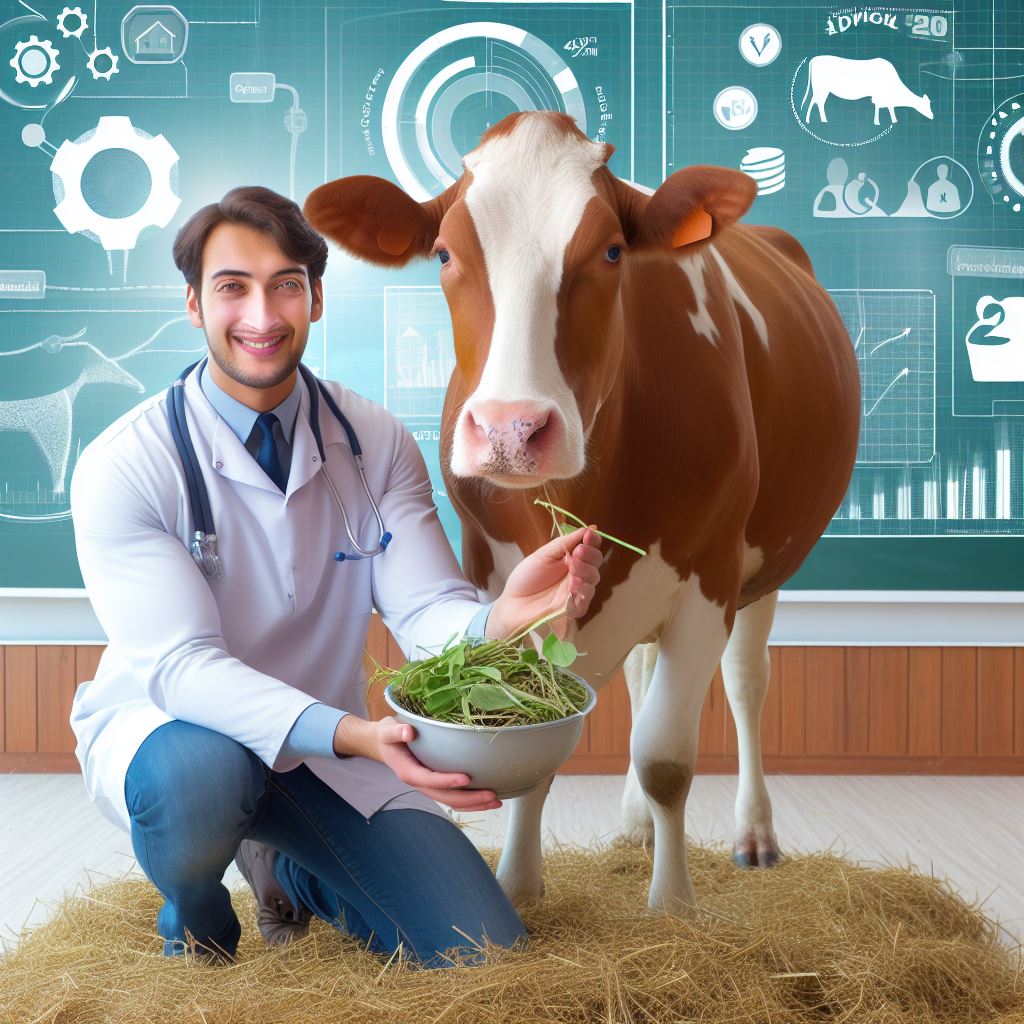Introduction
Brief explanation of sustainable sheep rearing
In recent years, there has been a growing recognition of the importance of sustainable sheep rearing practices.
As the demand for ethically sourced and environmentally friendly products continues to rise, farmers are increasingly adopting sustainable methods to meet consumer expectations.
Sustainable sheep rearing involves implementing practices that minimize the use of chemical inputs, reduce greenhouse gas emissions, and promote biodiversity conservation.
Importance of sustainable practices in sheep farming
By adopting sustainable practices, farmers can ensure the health and well-being of their flocks while also reducing the environmental impact of their operations.
One key aspect of sustainable sheep rearing is pasture management.
Rotational grazing allows sheep to feed on fresh and varied forage, preventing overgrazing and soil erosion.
This practice not only improves the quality of the pasture but also helps sequester carbon in the soil, mitigating climate change.
Additionally, sustainable sheep farmers prioritize animal welfare by providing proper nutrition, healthcare, and comfortable living conditions.
They avoid the routine use of antibiotics and hormones, instead opting for natural remedies and preventative measures to keep their sheep healthy.
This not only contributes to the health of the animals but also reduces the potential for antibiotic resistance in both animals and humans.
Therefore, sustainable sheep rearing is essential for the future of the sheep farming industry.
By implementing environmentally friendly and animal welfare-focused practices, farmers can meet the demands of consumers while ensuring the long-term viability of their operations.
Ultimately, sustainable sheep rearing benefits not only the farmers but also the environment and society as a whole.
Selecting the Right Breeds
Choosing the right breeds for sustainable sheep rearing is crucial for the success of your operation.
Different sheep breeds have varying characteristics that make them more or less suitable for sustainable farming practices.
Transform Your Agribusiness
Unlock your farm's potential with expert advice tailored to your needs. Get actionable steps that drive real results.
Get StartedHere is an overview of different sheep breeds that are commonly known for their adaptability to sustainable rearing.
Overview of different sheep breeds suitable for sustainable rearing
- Merino: Merino sheep are highly prized for their fine wool production and adaptable nature. They are suitable for a wide range of climates and can graze efficiently on both grass and shrublands.
- Rambouillet: Rambouillet sheep are known for their excellent wool quality and adaptability to various climates. They have a strong flocking instinct, which aids in efficient grazing and reduces predation risk
- Katahdin: Katahdin sheep are a hair breed, meaning they do not require shearing. They have good resistance to parasites and are known for their excellent meat quality.
- Dorper: Dorper sheep are hardy and adaptable to arid environments. They have a high fertility rate and excellent meat production, making them suitable for sustainable meat production.
- Romeldale CVM: Romeldale CVM sheep are a rare breed known for their soft, fine wool. They have good resistance to common diseases and are excellent grazers.
Factors to consider when choosing breeds for sustainability
When selecting breeds for sustainable rearing, it is essential to consider various factors:
- Climate adaptability: Choose breeds that can withstand the specific climate conditions in your area. Sheep that are well-suited to the local climate require less shelter and management.
- Grazing behavior: Sheep with efficient grazing behavior make better use of available pasture resources. Look for breeds that have a natural instinct to seek out diverse forage and efficiently convert it into meat or wool.
- Resistance to common diseases: Choose breeds that have developed natural resistance to prevalent diseases in your region. This reduces the need for medication and veterinary intervention, making your operation more sustainable.
Most importantly, selecting the right breeds for sustainable sheep rearing is crucial for the long-term success of your operation.
Consider climate adaptability, grazing behavior, and resistance to common diseases when choosing breeds.
By carefully selecting the right breeds, you can maximize the sustainability and profitability of your sheep rearing venture.
Read: Eco-Friendly Beef Farming: A Guide
Providing Adequate Grazing Land
Importance of Ample Grazing Land for Sustainable Sheep Farming
Having sufficient grazing land is crucial for sustainable sheep rearing because it provides a natural and nutritious food source for the animals.
It allows them to exhibit their natural foraging behavior, which promotes overall health and well-being.
Here are some key reasons why ample grazing land is essential:
- Nutritional Benefits: Grazing on diverse pasture allows sheep to access a variety of plant species, resulting in a well-balanced diet. This helps prevent nutritional deficiencies and improves the quality of the meat and wool produced.
- Exercise and Mental Stimulation: Ample grazing land provides ample space for sheep to roam, exercise, and engage in natural behaviors. This promotes better muscle development, stronger immune systems, and reduces stress-related behaviors.
- Sustainable Land Management: Proper grazing land management helps prevent overgrazing and soil erosion. It allows the land to regenerate and maintain its productivity, ensuring long-term sustainability for both the sheep and the environment.
Tips for Managing Grazing Land Effectively
To ensure effective management of grazing land, sheep farmers must implement various strategies and techniques.
Here are some tips to consider:
Rotational Grazing Techniques
Rotational grazing involves dividing the grazing land into smaller paddocks and rotating sheep between them.
This method prevents overgrazing, allows for better pasture rest and recovery, and promotes even utilization of forage resources.
It also helps control parasites by interrupting their lifecycle.
Rest Periods for Pasture Recovery
Allowing sufficient rest periods for pastures to recover after grazing is crucial.
This gives plants time to regrow, replenish their energy reserves, and maintain their overall health and vigor.
Rest periods also help control the spread of diseases and parasites.
Implementing Fencing Systems for Controlled Grazing
Erecting fencing systems, such as electric or permanent fences, helps control the movement of sheep and ensures controlled grazing.
This allows farmers to manage pasture utilization effectively and prevents sheep from overgrazing sensitive areas or escaping to unsuitable terrain.
Properly designed fencing can also protect pastures from external factors like wildlife or unauthorized human activity.
By adopting these practices, sheep farmers can optimize the utilization of grazing land and promote sustainable sheep rearing.
Careful planning and regular monitoring of the land’s condition are essential for successful implementation.
Remember, healthy grazing land leads to healthy sheep, increased productivity, and a more sustainable farming system.
In the next section, we will discuss the importance of freshwater sources and adequate shelter for sustainable sheep rearing. Stay tuned!
Showcase Your Farming Business
Publish your professional farming services profile on our blog for a one-time fee of $200 and reach a dedicated audience of farmers and agribusiness owners.
Publish Your ProfileRead: Pasture Renovation: When & How

Feeding and Nutrition
Feeding and nutrition play a crucial role in sustainable sheep rearing.
By adopting appropriate feeding practices, you can enhance the health and productivity of your flock while minimizing environmental impact.
Sustainable feeding practices for sheep
When it comes to sustainable feeding practices for sheep, a balanced diet is key.
Sheep require a mix of carbohydrates, proteins, fats, vitamins, and minerals to thrive.
A well-balanced diet not only supports healthy growth and development but also boosts reproductive efficiency and overall performance.
Tips for managing pasture and supplementing with hay or grains
Managing pasture is an integral part of sustainable sheep rearing. Rotate pastures frequently to allow forage recovery and avoid overgrazing, which can lead to soil degradation and reduced plant diversity.
Additionally, supplementing pasture with hay or grains enhances the diet and compensates for any nutrient deficiencies present in the grazing land.
Monitoring forage quality
To ensure the nutritional needs of your sheep are met sustainably, it is essential to monitor forage quality.
Regularly assess the nutritional content of the available forage to determine if additional supplementation is required.
This helps maintain optimal health and avoids any nutritional imbalances.
Using local and organic feed sources
When choosing feed sources, prioritize local and organic options.
Supporting local farmers not only reduces the carbon footprint associated with transportation but also promotes a more resilient and sustainable local food system.
Organic feeds minimize the use of synthetic fertilizers and pesticides, ensuring a healthier and more environmentally friendly diet for your sheep.
Ensuring access to fresh water at all times
Apart from the right diet, access to fresh water is paramount for sheep’s well-being and optimal productivity.
Sheep should always have access to clean, fresh water, particularly during hot weather or lactation periods.
Regularly check the water sources and ensure they are clean, well-maintained, and easily accessible to your flock.
In essence, sustainable sheep rearing requires careful attention to feeding and nutrition.
Implementing sustainable feeding practices, maintaining a balanced diet, managing pastures effectively, and ensuring access to fresh water are essential for the well-being and productivity of your sheep.
By adopting these tips, you can nurture a healthy and sustainable flock while minimizing environmental impacts.
Read: Herbicides in Pasture Management
Disease Prevention and Health Maintenance
Overview of common sheep diseases and their impact on sustainability
Sheep are susceptible to numerous diseases that can greatly affect the sustainability of sheep rearing.
These diseases not only lead to economic losses but also compromise the welfare of the animals.
Common sheep diseases include foot rot, internal parasites, respiratory infections, and mastitis.
Foot rot, caused by bacteria, leads to lameness and decreased mobility in sheep. Internal parasites such as worms can result in weight loss, anemia, and even death.
Respiratory infections can cause pneumonia, leading to reduced growth and reproductive issues.
These diseases have a detrimental impact on the sustainability of sheep rearing by reducing the overall productivity and profitability of the flock.
Sick sheep require additional veterinary care, medications, and management practices, which increase expenses for the farmer.
Moreover, diseased animals may not perform optimally, resulting in decreased wool and meat production.
This not only affects the farmer’s income but also impacts the availability and affordability of sheep products in the market.
Proactive measures to prevent diseases in sheep
To ensure the sustainability of sheep rearing, it is essential to implement proactive measures to prevent diseases.
These measures include vaccination programs, proper hygiene and sanitation practices, and regular health check-ups along with parasite control.
Vaccination programs
Vaccinations are an effective way to prevent the outbreak and spread of various diseases.
Sheep farmers should consult with a veterinarian to develop a suitable vaccination schedule based on the prevalent diseases in their region.
This will help promote sheep health and prevent the occurrence of costly illnesses.
Proper hygiene and sanitation practices
Maintaining a clean and hygienic environment is crucial for disease prevention. Sheep should be provided with clean drinking water, dry and well-ventilated shelters, and clean feeding troughs. Regular cleaning and disinfection of the sheep housing and equipment help reduce the risk of disease transmission and reinfection.
Regular health check-ups and parasite control:
Frequent health check-ups by a veterinarian can help identify and manage potential health issues in the flock.
Routine examinations, such as fecal egg counts, can detect internal parasites and inform parasite control strategies.
Deworming sheep based on veterinary recommendations helps minimize the risk of parasitic infestations.
Showcase Your Farming Business
Publish your professional farming services profile on our blog for a one-time fee of $200 and reach a dedicated audience of farmers and agribusiness owners.
Publish Your ProfileImplementing these proactive measures will significantly reduce the occurrence of diseases in sheep and contribute to the overall sustainability of the rearing practices.
It will enhance animal welfare, productivity, and profitability for the farmer.
In fact, disease prevention and health maintenance play a crucial role in ensuring the sustainability of sheep rearing.
Farmers should be aware of common sheep diseases and their impact on productivity and profitability.
By implementing proactive measures such as vaccination programs, proper hygiene, and regular health check-ups, farmers can minimize disease risks and promote a healthy and sustainable sheep flock.
Read: Winter Care for Grazing Pastures
You Might Also Like: Responsible Dairy Farming Tips
Sustainable Sheep Housing
Importance of comfortable and environmentally-friendly housing for sheep
Sheep housing plays a crucial role in ensuring the well-being and sustainability of these animals.
Proper housing not only provides comfort but also contributes to their overall health and productivity.
Comfortable and environmentally-friendly housing is essential for sheep because it directly affects their welfare, behavior, and productivity.
Sheep that are housed in inadequate conditions may experience stress, weakened immune systems, and reduced growth rates.
To create a comfortable environment, sheep shelters should offer protection from extreme weather conditions such as excessive heat, cold, wind, and rain.
This protection helps prevent diseases, stress, and reduces the need for additional medication.
Furthermore, environmentally-friendly housing is essential to reduce the carbon footprint of sheep rearing.
Constructing sustainable sheep shelters can contribute to the conservation of natural resources and promote ecological balance.
Tips for constructing sustainable sheep shelters
To construct sustainable sheep shelters, here are some valuable tips to consider:
Using natural or recycled building materials
Using natural or recycled building materials reduces the demand for new resources and minimizes waste production.
Materials like wood, bamboo, straw, or reclaimed materials can be used for constructing sheep shelters.
Designing for proper ventilation and insulation
Proper ventilation is crucial for providing fresh air and reducing moisture levels inside the sheep shelter.
This can be achieved by incorporating windows, vents, and properly designed openings.
Insulation is also necessary to maintain stable and comfortable temperatures.
Managing waste and manure effectively
Managing waste and manure is vital to prevent pollution and maintain a clean and healthy environment.
Utilizing manure as organic fertilizer can reduce the reliance on synthetic fertilizers and promote sustainable agricultural practices.
By following these tips, sustainable sheep housing can be achieved, benefiting both the animals and the environment.
Creating comfortable and eco-friendly shelters enhances the welfare of sheep, leading to improved productivity and overall sustainability of sheep rearing practices.
Thus, it is crucial for sheep farmers to understand and implement sustainable housing practices for the well-being of the animals and the conservation of the environment.
Impact of Sustainable Sheep Rearing on the Environment
Benefits of Sustainable Sheep Farming for the Environment
- Improved soil health and fertility through sustainable grazing practices.
- Reduced soil erosion and runoff due to careful management of pasture rotation.
- Enhanced water quality as sustainable sheep farming prevents water pollution from excessive waste and chemicals.
- Preservation of habitat for various species by promoting diverse native vegetation on pastures.
- Decreased dependence on synthetic fertilizers and pesticides, leading to less air and water pollution.
Reduction of Carbon Footprint through Sustainable Practices
- Limited greenhouse gas emissions, as sustainable sheep rearing promotes pasture-based feeding rather than grain-fed diets.
- Responsible waste management, including proper disposal of sheep feces to prevent the release of methane, a potent greenhouse gas.
- Efficient use of resources such as water and energy through sustainable farming methods.
- Carbon sequestration through the reestablishment of natural grasslands, which act as carbon sinks.
Preservation of Biodiversity and Natural Resources
- Sustainable sheep farming practices maintain diverse ecosystems, supporting a variety of plant and animal species.
- Preservation of native grasslands and pastures, which serve as critical habitats for many wildlife species.
- Protection of water bodies from contamination, benefiting aquatic organisms and preserving aquatic biodiversity.
- Conservation of valuable natural resources, including soil, water, and air, for future generations.
- Maintenance of ecological balance by minimizing the use of chemical inputs and promoting natural pest control methods.
In short, sustainable sheep rearing has a positive impact on the environment through various benefits.
By implementing sustainable farming practices, sheep farmers can improve soil health, reduce carbon emissions, preserve biodiversity, and protect natural resources.
These practices not only benefit the environment but also contribute to the overall sustainability and long-term viability of sheep farming.
Conclusion
Recap of the key tips for sustainable sheep rearing
- Provide adequate pasture and grazing management to ensure proper nutrition for the sheep.
- Practice rotational grazing to promote soil health and prevent overgrazing.
- Use natural and organic methods for parasite control to minimize the use of chemicals.
- Implement proper housing and shelter to protect the sheep from extreme weather conditions.
- Maintain a clean and hygienic environment to reduce the risk of diseases and infections.
- Focus on breeding from healthy and resilient sheep to build a sustainable flock.
Encouragement to implement sustainable practices for a better future in sheep farming
By adopting sustainable sheep rearing practices, farmers can not only ensure the welfare and productivity of their flock but also contribute to environmental conservation.
Implementing these tips will lead to healthier sheep, improved soil quality, and reduced reliance on chemicals.
Furthermore, sustainable practices can help preserve natural resources, protect biodiversity, and mitigate climate change.
By embracing sustainability, sheep farmers can contribute to a better future for themselves, their communities, and the planet as a whole.
Let us work together to create a sustainable and prosperous future in sheep farming.




